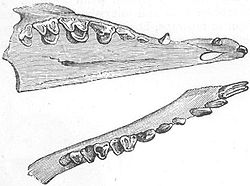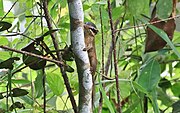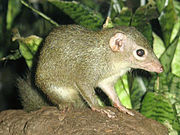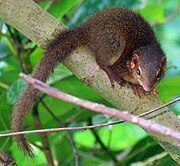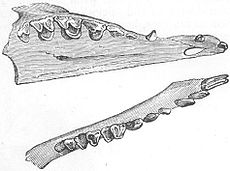Scandentia
The scandentians (Scandentia) are an order of placental mammals commonly known as tupayas or tree shrews. They are small animals that live in the jungles of Southeast Asia. It is the group closest to primates, after the dermoptera.
This order comprises two families: Tupaiidae, with four genera, and Ptilocercidae, with one.
Description
Tree shrews are slender animals with long tails and soft grayish to reddish-brown fur. Terrestrial species are usually larger than tree-dwelling species and have larger claws, which they use to dig up insects. They have poorly developed canine teeth and poorly specialized molars, with a global dental formula of 2.1.3.3 / 3.1.3.3.
They are climbing species that have good vision, binocular in the case of the more arboreal species.
Playback
Females have a gestation period of 45-50 days and give birth to up to three young in nests lined with dry leaves in tree holes. The young are born blind and hairless, but are able to leave the nest after a month. During this period, the mother provides relatively little maternal care, visiting her young for only a few minutes every other day to nurse.
These shrews are sexually mature at four months and breed for much of the year, with no clear breeding season for most species.
Behavior
They live in small family groups that defend their territory from intruders. Most are diurnal, although the long-tailed shrew is nocturnal.
They mark their territory with scent glands or urine, depending on the species.
Diet
These tree shrews are omnivorous, feeding on insects, small vertebrates, fruit, and seeds. Among other things, they eat Rafflesia fruits.
In Malaysia, the long-tailed shrew is capable of consuming large amounts of naturally fermented nectar from the cocoons of the bertam palm Eugeissona tristis (with up to 3.8% alcohol content) throughout the year without affecting its health. behavior.
Shrews have also been observed to intentionally eat foods high in capsaicin and Cap2, a behavior unique among mammals other than humans. A single TRPV1 mutation reduces their pain response to capsaicinoids, which scientists believe is an evolutionary adaptation to being able to consume spicy foods in their natural habitats.
Phylogeny
Members of this order were first considered to be Insectivora, but were later included in the order Primates by Sir Wilfred Le Gros Clark, on the basis of certain anatomical similarities with them, such as brain structure, and classified as primitive prosimians. Tupayas have the highest brain-to-body-mass ratio of any mammal, including humans.
However, recent molecular phylogenetic studies have shown that the tupayas must have the same taxonomic category (order) as the primates, within the Euarchonta clade, which also includes the dermoptera. According to these studies, Euarchonta is the sister group to the Glires (Lagomorpha + Rodentia), and Euarchonta + Glires form the higher-ranking clade Euarchontoglires. However, other relationships between these orders have been proposed.
| Euarchontoglires |
| ||||||||||||||||||||||||||||||
Taxonomy
- Order Scandentia
- Tupaiidae
- Gender Anathana
- Anathana ellioti
- Gender Dendrogale
- Dendrogale melanura
- Dendrogale murine
- Gender Tupaia
- Tupaia belangeri
- Tupaia chrysogaster
- Tupaia dorsalis
- Tupaia glis
- Tupaia gracilis
- Tupaia javanica
- Tupaia longipes
- Minor Tupaia
- Tupaia moellendorffi
- Tupaia montana
- Nicobaric Tupaia
- Tupaia palawanensis
- Tupaia picta
- Tupaia splendidula
- Tupaia tana
- Gender Urogale
- Urogale evereti
- Gender Anathana
- Ptilocercidae Family
- Gender Ptilocercus
- Ptilocercus lowii
- Gender Ptilocercus
- Tupaiidae
Furthermore, fossils attributable to this order have turned up throughout Asia, dating back to the Miocene period (there is an Eocene genus, Eodendrogale, that could be included in the order); includes genres such as Prodendrogale and Palaeotupaia.
Contenido relacionado
Plantago lanceolata
Fumaria capreolata
Lophopogon
